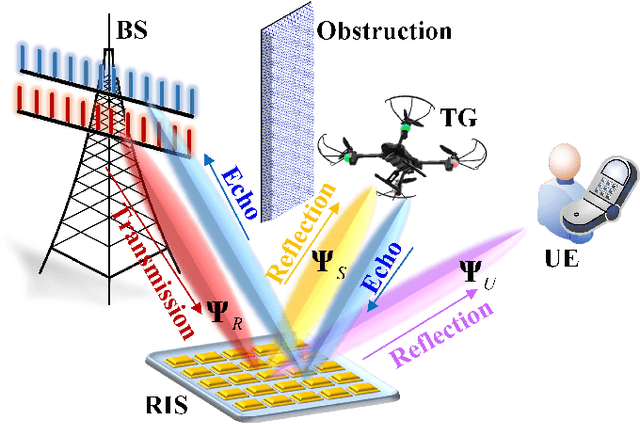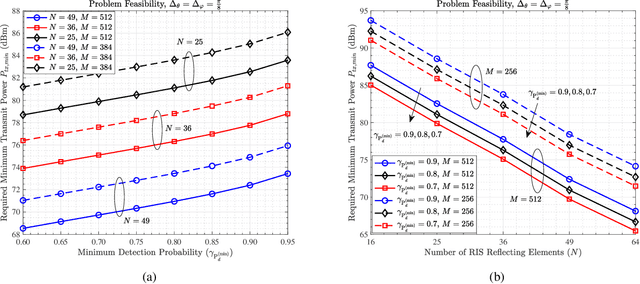Zhe Xing
Near-Field Localization and Phase Shift Optimization for RIS-Assisted Non-Ideal OFDM Systems
Dec 19, 2023Abstract:By incorporating reconfigurable intelligent surface (RIS) into communication-assisted localization systems, the issue of signal blockage caused by obstacles can be addressed, and passive beamforming can be employed to enhance localization accuracy. However, existing works mainly consider ideal channels and do not account for the effects of realistic impairments like carrier frequency offset (CFO) and phase noise (PN) on localization. This paper proposes an iterative joint estimation algorithm for CFO, PN, and user position based on maximum a posteriori (MAP) criterion and gradient descent (GD) algorithm. Closed-form expressions for CFO and PN updates are provided. The hybrid Cram\'{e}r-Rao lower bound (HCRLB) for the estimation parameters is derived, and the ambiguity in CFO and PN estimation is analyzed. To minimize the HCRLB, a non-convex RIS shift optimization problem is formulated and is transformed into a convex semidefinite programming (SDP) problem using the technique of semidefinite relaxation (SDR) and Schur complement. After optimizing the RIS phase shift, the theoretical positioning accuracy within the area of interest (AOI) can be improved by two orders of magnitude, with a maximum positioning root mean square error (RMSE) lower than $\rm 10^{-2}m$.
Passive Beamforming Design for Reconfigurable Intelligent Surface Enabled Integrated Sensing and Communication
Jun 01, 2022



Abstract:To exploit the potential of the reconfigurable intelligent surface (RIS) in supporting the future integrated sensing and communication (ISAC), this paper proposes a novel passive beamforming strategy for the RIS-enabled ISAC (RIS-ISAC) system in consideration of the target size. To this end, the detection probability for target sensing is derived in closed-form based on the illumination power on an approximated scattering surface area (SSA) of the target, and a new concept of ultimate detection resolution (UDR) is defined for the first time to measure the capability of the target detection. Subsequently, an optimization problem is formulated to maximize the signal-to-noise ratio (SNR) at the user-equipment (UE) under a minimum detection probability constraint. To solve this problem, a novel convexification process is performed to convexify the detection probability constraint with matrix operations and a real-valued first-order Taylor approximation. The semidefinite relaxation (SDR) is then adopted to relax the problem. A successive convex approximation (SCA) based algorithm is finally designed to yield a phase-shift solution, followed by a detailed analysis on the problem feasibility condition as well as the algorithm convergence. Our results reveal the inherent trade-offs between the sensing and the communication performances, and between the UDR and the duration of a sensing time slot. In comparison with two existing approaches, the proposed strategy is validated to be superior when detecting targets with practical sizes.
Location Information Assisted Beamforming Design for Reconfigurable Intelligent Surface Aided Communication Systems
Oct 18, 2021



Abstract:In reconfigurable intelligent surface (RIS) aided millimeter-wave (mmWave) communication systems, in order to overcome the limitation of the conventional channel state information (CSI) acquisition techniques, this paper proposes a location information assisted beamforming design without the requirement of the conventional channel training process. First, we establish the geometrical relation between the channel model and the user location, based on which we derive an approximate CSI error bound based on the user location error by means of Taylor approximation, triangle and power mean inequalities, and semidefinite relaxation (SDR). Second, for combating the uncertainty of the location error, we formulate a worst-case robust beamforming optimization problem. To solve the problem efficiently, we develop a novel iterative algorithm by utilizing various optimization tools such as Lagrange multiplier, matrix inversion lemma, SDR, as well as branch-and-bound (BnB). Particularly, the BnB algorithm is modified to acquire the phase shift solution under an arbitrary constraint of possible phase shift values. Finally, we analyse the algorithm complexity, and carry out simulations to validate the theoretical derivation of the CSI error bound and the robustness of the proposed algorithm. Compared with the existing non-robust approach and the robust beamforming techniques based on S-procedure and penalty convex-concave procedure (CCP), our method converges faster and achieves better performance in terms of the worst-case signal-to-noise ratio (SNR) at the receiver.
 Add to Chrome
Add to Chrome Add to Firefox
Add to Firefox Add to Edge
Add to Edge